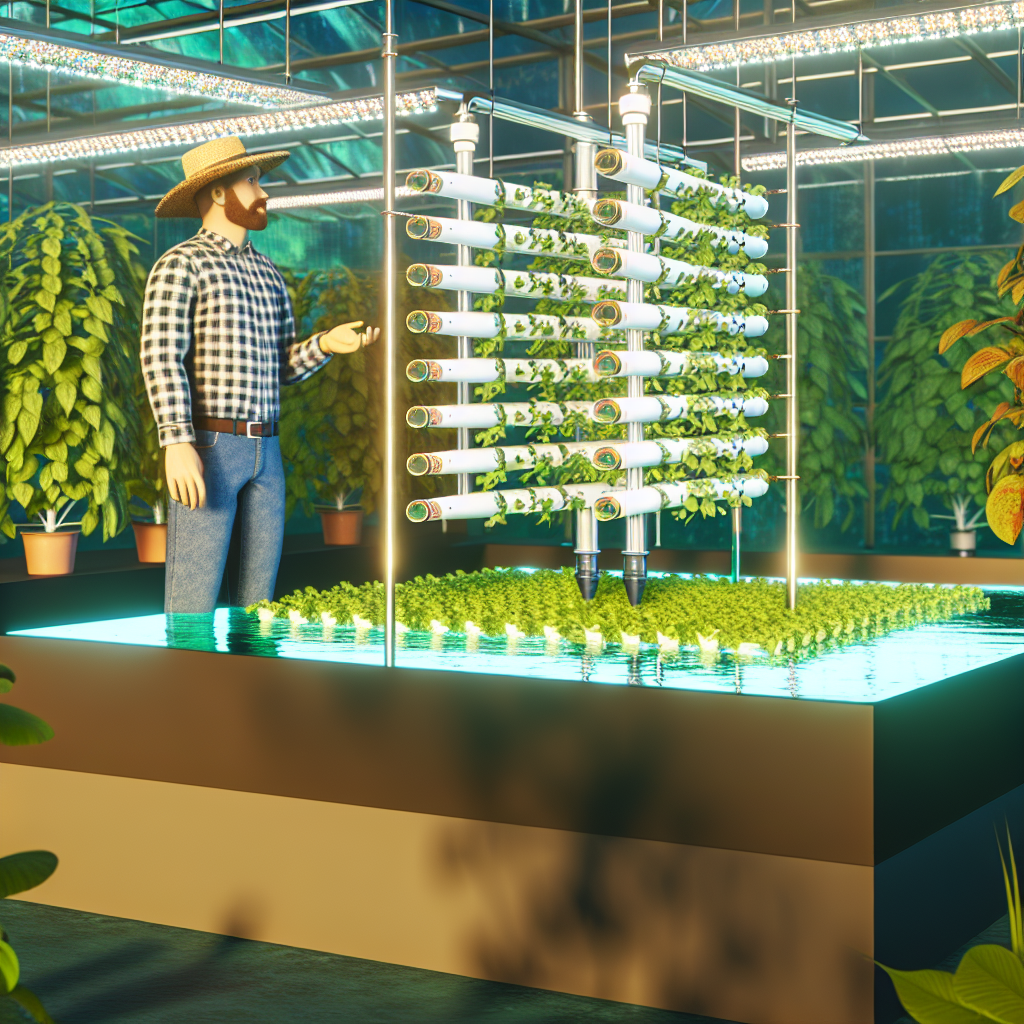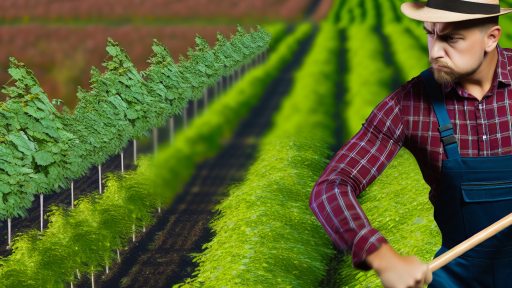Introduction to Hydroponics and Its Importance in Water-Efficient Farming
Hydroponics involves growing plants without soil.
This method uses nutrient-rich water to nourish plants directly.
Consequently, it maximizes resource efficiency.
One major benefit is its optimal water use.
Hydroponics can reduce water consumption by up to 90% compared to traditional farming.
This efficiency is crucial for regions facing water scarcity.
Furthermore, hydroponics boosts productivity in limited spaces.
It allows for year-round cultivation, regardless of weather conditions.
This adaptability leads to increased food security.
Additionally, hydroponic systems minimize pesticide use.
Farmers can grow healthier produce with fewer harmful chemicals.
This practice supports sustainable agriculture and environmental health.
Hydroponics also offers a solution to urban farming challenges.
Cities can incorporate vertical farms to meet local food demands.
Hydroponics represents a modern approach to agriculture.
Transform Your Agribusiness
Unlock your farm's potential with expert advice tailored to your needs. Get actionable steps that drive real results.
Get StartedIt addresses critical issues such as resource efficiency and food sustainability.
Benefits of Hydroponics Over Traditional Farming Methods
Water Efficiency
Hydroponics uses significantly less water than traditional farming.
It recycles water, minimizing waste effectively.
This method can use up to 90% less water.
Moreover, precise water management aids plant growth.
Faster Growth Rates
Plants in hydroponic systems often grow faster than in soil.
This results from optimal nutrient delivery and environmental control.
Additionally, growers can harvest more frequently.
This efficiency boosts overall productivity.
Space Optimization
Hydroponics can be implemented in limited spaces.
Vertical farming systems maximize available area.
This flexibility allows farming in urban environments.
Furthermore, it can lead to higher yields per square foot.
Pest and Disease Control
Hydroponic systems reduce the risk of soil-borne pests.
This minimizes the need for harmful pesticides.
As a result, crops can be cleaner and healthier.
Additionally, it simplifies monitoring plant health.
Year-Round Production
Hydroponics allows for continuous cropping cycles.
Growers can produce food regardless of seasonal changes.
This consistency helps meet year-round food demands.
Ultimately, it leads to a stable food supply chain.
Key Hydroponic Systems and Their Water Usage Efficiency
Understanding Hydroponics
Hydroponics involves growing plants without soil.
Instead, it uses nutrient-rich water solutions.
This method ensures efficient water use and increased yield.
Showcase Your Farming Business
Publish your professional farming services profile on our blog for a one-time fee of $200 and reach a dedicated audience of farmers and agribusiness owners.
Publish Your ProfileTypes of Hydroponic Systems
Several hydroponic systems exist, each with unique features.
Understanding these systems helps improve water efficiency.
Nutrient Film Technique (NFT)
NFT uses a thin film of nutrient solution over plant roots.
This system efficiently recirculates water.
Moreover, it reduces water usage greatly.
Deep Water Culture (DWC)
DWC immerses plant roots in oxygenated nutrient solution.
This technique enhances nutrient uptake.
Consequently, plants grow quickly while requiring less water.
Drip Systems
Drip systems deliver nutrient solution directly to plant roots.
This targeted approach minimizes waste and ensures efficiency.
As a result, water consumption is significantly reduced.
Comparative Water Efficiency
Hydroponic systems typically use 70-90% less water than traditional farming.
Understanding their efficiency can improve sustainable farming practices.
Furthermore, farmers can benefit economically from reduced water costs.
Adoption of Hydroponics
As water scarcity increases, hydroponics becomes vital.
This method allows farming in urban areas with limited space.
Adopting hydroponics can lead to sustainable water management.
Explore Further: Water Management Techniques For Healthy Soil
Selecting the Right Crops for Hydroponic Cultivation
Understanding Crop Suitability
Choosing the right crops for hydroponic systems is crucial for success.
Consider light requirements, growth cycles, and nutrient needs.
Some crops thrive in hydroponic environments, while others do not.
Popular Hydroponic Crops
Let’s explore some of the most suitable crops for hydroponics.
- Lettuce is a fast-growing and highly popular crop.
- Spinach provides a nutrient-dense option for growers.
- Herbs, such as basil and cilantro, flourish in hydroponic systems.
- Strawberries can be successfully grown using hydroponics.
Crops Requiring Special Considerations
Not all crops fit into a hydroponic model seamlessly.
Crops like tomatoes and peppers need extra attention for optimal growth.
These plants may require more space and support than others.
Seasonal Considerations
The growth cycle affects crop selection in hydroponics.
Fast-growing plants are preferable for quicker yields.
Seasonal crops may need controlled environments to thrive year-round.
Researching Local Markets
Understanding local demand is key when selecting crops.
Identify which crops are popular in your area.
This knowledge will guide your decisions and improve profitability.
Testing Crop Viability
Before fully committing to any crop, conduct trials.
Start with small batches to assess growth and yield.
Evaluate the growth conditions required and adjust as necessary.
Learn More: Integrated Pest Management for Organic Farming
Initial Setup and Investment for Hydroponic Systems
Understanding Hydroponic Systems
Hydroponics uses nutrient-rich water to grow plants without soil.
This method maximizes resource efficiency and minimizes water use.
Experts identify multiple hydroponic techniques, including deepwater culture and nutrient film technique.
Assessing Your Space
Begin by analyzing your available space for hydroponic setup.
Indoor environments often require additional grow lights.
Showcase Your Farming Business
Publish your professional farming services profile on our blog for a one-time fee of $200 and reach a dedicated audience of farmers and agribusiness owners.
Publish Your ProfileOutdoor setups benefit from natural sunlight but may need shade.
Make sure the location has a reliable source of water and electricity.
Choosing the Right Equipment
Selecting the appropriate equipment is crucial for success.
Common components include tanks, pumps, and growing trays.
Invest in high-quality seeds and nutrient solutions as well.
Consider purchasing a hydroponic system kit to simplify setup.
Initial Investment Considerations
Calculate your initial investment costs to ensure feasibility.
Typical startup costs range from a few hundred to several thousand dollars.
Factor in expenses for equipment, seeds, and nutrient solutions.
Also, consider potential ongoing costs such as electricity and water.
Setting a Budget
Establish a clear budget to monitor your financial commitment.
Include all potential expenses in your budget for accuracy.
Set aside funds for unexpected repairs or upgrades.
Exploring Funding Options
Look into various funding options if your budget falls short.
Grants and loans are available for innovative agricultural projects.
Local agricultural programs may offer assistance as well.
Networking with other hydroponic farmers can provide insights into financing.
Finalizing Your Setup
Once you purchase all necessary equipment, proceed with setup.
Follow manufacturer instructions carefully for best results.
After assembling, test the system components to ensure functionality.
Complete system testing allows for adjustments before planting.
Monitoring Your Investment
Regularly evaluate your hydroponic farming sustainability.
Keep track of yields, expenses, and system performance.
Adjust practices based on performance data for better outcomes.
Consistent monitoring leads to increased efficiency and profitability.
See Related Content: Implementing Crop Diversity for Sustainable Farming

Maintaining Optimal Water Quality in Hydroponic Systems
Importance of Water Quality
Water quality directly impacts plant growth in hydroponic systems.
High-quality water promotes nutrient absorption and healthy growth.
Additionally, it helps prevent diseases that can harm plants.
Key Parameters to Monitor
Several key parameters determine water quality in hydroponics.
pH levels must be maintained between 5.5 and 6.5.
Regularly testing electrical conductivity (EC) ensures nutrient levels are optimal.
Temperature control is also crucial for overall system performance.
Keep dissolved oxygen levels high to support healthy roots.
Maintaining Clean Water Sources
Using filtered water prevents contaminants from entering the system.
Consider using reverse osmosis systems for improved water quality.
Regularly change water to reduce the buildup of harmful bacteria.
Regular Testing and Adjustments
Frequent water testing is essential for maintaining quality.
Adjust pH levels using commercial pH up or down solutions.
Periodically monitor nutrient concentrations to ensure balance.
Showcase Your Farming Business
Publish your professional farming services profile on our blog for a one-time fee of $200 and reach a dedicated audience of farmers and agribusiness owners.
Publish Your ProfileUtilize test kits that provide accurate readings of key parameters.
Implementing a Maintenance Schedule
Establish a regular maintenance schedule for your hydroponic system.
This schedule should include water changes and equipment checks.
Set reminders for routine water quality testing.
Document any changes to detect long-term trends in water quality.
Utilizing Technology for Monitoring
Investing in technology can streamline water quality management.
Automated sensors can provide real-time readings of water parameters.
Data logging systems can track performance over time.
Integrating software tools can aid in analyzing trends effectively.
Gain More Insights: Conservation Tillage Strategies For Crop Success
Integrating Renewable Energy Solutions in Hydroponic Farms
Importance of Renewable Energy in Agriculture
Renewable energy plays a crucial role in modern agriculture.
It reduces dependency on fossil fuels and decreases greenhouse gas emissions.
Additionally, it provides a reliable energy source for hydroponic systems.
Types of Renewable Energy Suitable for Hydroponic Farms
There are several types of renewable energy suitable for hydroponic farming.
Solar energy is the most common choice among farmers.
Solar panels can power lights, pumps, and other essential equipment.
Wind energy is another option for high-wind areas.
Hydro power can also be used in regions with flowing water sources.
Implementing Solar Energy Solutions
Implementing solar panels can significantly reduce energy costs.
Farmers can use net metering to sell excess energy back to the grid.
Additionally, solar water heaters can efficiently warm nutrient solutions.
By utilizing photovoltaic systems, farms can become more self-sufficient.
Utilizing Wind Energy for Increased Efficiency
Wind turbines can complement solar energy systems effectively.
They can generate electricity during cloudy or low-sunlight days.
Moreover, small wind turbines are becoming more popular among farmers.
They can provide energy for both hydroponic operations and irrigation systems.
Benefits of Integrating Renewable Energy
Integrating renewable energy enhances sustainability in farming.
It lowers operational costs through energy savings.
Furthermore, it contributes to reducing carbon footprints.
Farmers who adopt renewable energy enjoy increased public support.
Challenges and Solutions
There can be initial investment challenges when implementing renewable systems.
However, grants and subsidies are available for many farmers.
Additionally, proper planning and system sizing can mitigate these challenges.
Farmers should also consider hybrid systems that combine energy sources.
Case Studies: Successful Hydroponic Farms Around the World
Vertical Harvest Farm in Jackson, Wyoming
Vertical Harvest Farm is an innovative hydroponic facility.
This farm utilizes vertical growing techniques to maximize space.
It provides fresh produce to the local community year-round.
Additionally, the farm employs 50 people, enhancing local employment.
Vertical Harvest champions sustainability through water-efficient practices.
Gotham Greens in Brooklyn, New York
Gotham Greens operates rooftop farms across urban New York City.
Showcase Your Farming Business
Publish your professional farming services profile on our blog for a one-time fee of $200 and reach a dedicated audience of farmers and agribusiness owners.
Publish Your ProfileTheir hydroponic systems use 95% less water than traditional farming.
Gotham Greens delivers fresh lettuce and herbs directly to local markets.
This model reduces transportation costs and greenhouse gas emissions.
Moreover, they focus on using renewable energy in their operations.
AeroFarms in Newark, New Jersey
AeroFarms is a leader in vertical farming technology.
Their facilities are designed to be energy-efficient and environmentally friendly.
AeroFarms produces high yields in a small footprint.
The company emphasizes growing without pesticides or herbicides.
Furthermore, they engage in research to improve crop varieties.
Sky Greens in Singapore
Sky Greens is known for its innovative vertical farming systems.
It serves as a model for urban agriculture in densely populated areas.
The farm utilizes a unique system that rotates plants to maximize sunlight.
As a result, they achieve high production rates with limited resources.
Sky Greens also aims to promote food security in Singapore.
Infarm in Berlin, Germany
Infarm is pioneering urban farming solutions in Europe.
Their modular systems can be installed in grocery stores and restaurants.
This accessibility allows for ultra-fresh produce delivery to consumers.
Infarm focuses on minimal water usage in all its installations.
Additionally, they are committed to reducing food waste through local sourcing.
Additional Resources
Sustainable Campus Initiatives: Spotlight on Hydroponic Farming
Hydroponics: current trends in sustainable crop production – PMC




